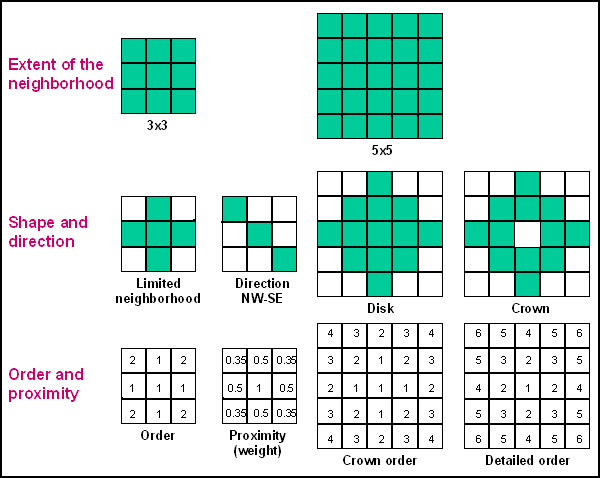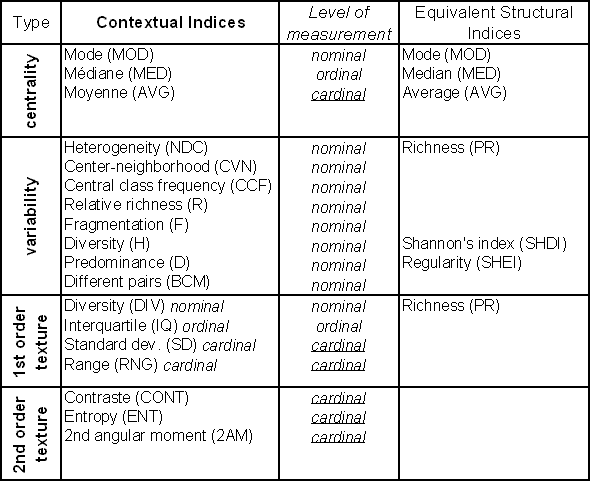Principles of the contextual analysis
To connect the thematic properties of each unit of observation with those of
their neighborhood, it is essential to define the neighborhood beforehand to be
considered, as well as the numerical indicator expressing this relation. The neighborhood
of analysis is expressed by the moving window which
identifies successively the set of neighbor entities to be processed. It is based on
the topological concept of adjacency of variable order. In image mode, the definition
of the moving window was already presented and its application was illustrated in the
Basic Module of Spatial Analysis (B-AN), in particular in Lesson 2. We point out simply
here the parameters of definition of the neighborhood in image mode and the types of
operators allowing to produce the indices of arrangement.
Parameters of definition of the neighborhood:
- size of the window: The moving window
is admitted as square by definition. Its size is expressed in a number
of columns and lines (CxL) which is generally odd so that the processed
cell in each successive step is centered in the window.
- the shape of the window: Only certain
cells in the moving window can be assigned as belonging to the neighborhood
of the central cell. The selective activation of the cells makes it possible
to define non square shape of neighborhood, dissymmetrical or directional.
- proximity to the central cell: The index
to be produced can consider the whole of the neighborhood indifferently, or can
take into account the order of the neighborhood or the distance to the central cell.
In this second alternative, weights will be
assigned to each cell of the neighborhood according to their distance to the
center of the window. That will produce weighted indices of arrangement.
|
Parameters of definition of the neighborhood in a moving window
|
|
|
- indices of central tendency:
They account for the general property
(central) in the whole of the neighborhood considered. They result from
statistical operators of central tendency (position) specific to each of
the three levels of measurement of the thematic contents.
- indices of variability:
They can be similar to the thematic indices
of structure presented previously, but calculated on the defined neighborhood.
They express the importance of the variation of properties in this neighborhood.
One finds there also other indices specific to this scale of analysis.
- indices of texture of first order:
They express in a global way the
variability or the dispersion of the properties present within the neighborhood.
They call upon statistical operators of dispersion adapted to the level of
measurement of the thematic variable.
- indices of texture of second order:
They return account in a finer way
of the transitions from properties between all the pairs of cells ordered
according to their proximity and optionally according to directions. Such
indices are made up from matrices of co-occurrence. They describe the texture
of properties principally measured on a cardinal level, therefore in image mode
they are mainly associated with continuous spatial distributions. So they will
not be described in this Unit, but the reader can familiarize himself with
their principle of calculation and their potential of application using the
following references: Caloz and Collet (2001, pp.262-269),
Haralick (1979, pp.786-804).
|
Types of contextual indices and their relationship to the indices of structure
|
|
|
 Figure 3.5
Figure 3.5 Table 3.5
Table 3.5